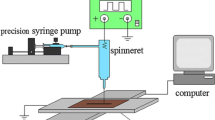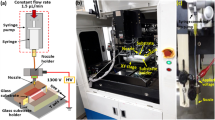Abstract
To improve the resolution of printed patterns fabricated with PEDOT:PSS organic conductive polymer printing solutions by an electrohydrodynamic (EHD) jet printing method, the EHD jet printing method based on the high-voltage electrostatic focusing lens was proposed based on the analysis of the theoretical model of the EHD jet printing method. Using the PEDOT:PSS mixed solution as the printing solution, flexible conductive patterns were printed on the photographic paper by the EHD jet printing method based on the high-voltage electrostatic focusing lens. The effects of the working voltage, the velocity of the motion platform, and the flow rate of the injection pump on the width of the printed patterns were analyzed. Compared with the traditional EHD jet printing method, it has been verified that the EHD jet printing method based on the high-voltage electrostatic focusing lens has higher resolution under the same printing conditions, which provides a new method for achieving high-resolution pattern printing of PEDOT:PSS organic conductive polymer printing solutions.










Similar content being viewed by others

Data availability
This article contains all the data gathered or analyzed during this study.
References
Kang MS, Han CY, Jeo H (2020) Submicrometer-scale pattern generation via maskless digital photolithography. Optica 7(12):1788–1795. https://doi.org/10.1364/OPTICA.406304
Kurematsu K, Takei S, Nakajima S, Mizui K, Takamatsu S, Hirata D, Hanabata M (2019) Comparison of gas permeable mold with acryl substituents for silver nano-paste imprint patterning. Microelectron Eng 216:111085. https://doi.org/10.1016/j.mee.2019.111085
Harnois M, Himdi M, Yong WY, Rahim SKA, Tekkouk K, Cheval N (2020) An improved fabrication technique for the 3-D frequency selective surface based on water transfer printing technology. Sci Rep 10(1):1714. https://doi.org/10.1038/s41598-020-58657-5
Nachimuthu M, Rajesh PK (2023) Inkjet four-dimensional printing of shape memory polymers: a review. Rapid Prototyp J 29(3):437–446. https://doi.org/10.1108/RPJ-08-2021-0198
Ye D, Ding YJ, Duan YQ, Su JT, Yin ZP, Huang YA (2018) Large-scale direct-writing of aligned nanofibers for flexible electronics. Small 14(21):1703521. https://doi.org/10.1002/smll.201703521
Kim DW, Min SY, Lee Y, Jeong U (2020) Transparent flexible nanoline field-effect transistor array with high integration in a large area. ACS Nano 14(1):907–918. https://doi.org/10.1021/acsnano.9b08199
Son S, Lee S, Choi J (2014) Fine metal line patterning on hydrophilic non-conductive substrates based on electrohydrodynamic printing and laser sintering. J Electrostat 72(1):70–75. https://doi.org/10.1016/j.elstat.2013.12.002
Lyu B, Im S, Jing H, Lee S, Kim SH, Kim JH, Cho JH (2020) Work function engineering of electrohydrodynamic-jet-printed PEDOT:PSS electrodes for high-performance printed electronics. ACS Appl Mater Interfaces 12(15):17811–17817. https://doi.org/10.1021/acsami.0c02580
Wang QL, Zhang GN, Zhang HY, Duan YQ, Yin ZP, Huang HA (2021) High-resolution, flexible, and full-color perovskite image photodetector via electrohydrodynamic printing of ionic-liquid-based ink. Adv Funct Mater 31(28):2100857. https://doi.org/10.1002/adfm.202100857
Mkhize N, Murugappan K, Castell MR, Bhaskaran H (2021) Electrohydrodynamic jet printed conducting polymer for enhanced chemiresistive gas sensors. J Mater Chem C 9(13):4591–4596. https://doi.org/10.1039/d0tc05719c
Kim K, Kim G, Lee BR, Ji S, Kim SY, An BW, Song MH, Park JU (2015) High-resolution electrohydrodynamic jet printing of small-molecule organic light-emitting diodes. Nanoscale 7(32):13410–13415. https://doi.org/10.1039/c5nr03034j
Daly AC, Riley L, Segura T, Burdick J (2020) Hydrogel microparticles for biomedical applications. Nat Rev Mater 5(1):20–43. https://doi.org/10.1038/s41578-019-0148-6
Kim M, Kim GH (2015) Electrohydrodynamic direct printing of PCL/collagen fibrous scaffolds with a core/shell structure for tissue engineering applications. Chem Eng J 279:317–326. https://doi.org/10.1016/j.cej.2015.05.047
Rahman TT, Arman MS, Perez V, Xu B, Li JZ (2021) Analysis of the operating conditions of pulse electric field-assisted EHD for sodium alginate printing using design of experiment approach. Int J Adv Manuf Tech 115(7–8):2037–2047. https://doi.org/10.1007/s00170-021-07042-1
Gao DJ, Yao DG, Leist SK, Fei YF, Zhou J (2019) Mechanisms and modeling of electrohydrodynamic phenomena. Int J Bioprinting 5(1):166. https://doi.org/10.18063/ijb.v5i1.166
Wu T, Zhang LB, Song HJ (2021) Control method of applied voltage for fabricating micro-pattern using near-field electrohydrodynamic direct-writing technology. AIP Adv 11(11):115120. https://doi.org/10.1063/5.0074069
Zheng GF, Yu ZJ, Zhuang MF, Wei W, Zhao Y, Zheng JY, Sun DH (2014) Electrohydrodynamic direct-writing of three-dimensional multi-loop nanofibrous coils. Appl Phys-Mater 116(1):171–177. https://doi.org/10.1007/s00339-014-8264-z
Jang S, Kim Y, Oh JH (2016) Influence of processing conditions and material properties on electrohydrodynamic direct patterning of a polymer solution. J Electron Mater 45(4):2305–2306. https://doi.org/10.1007/s11664-015-4327-y
Wang BL, Chen X, Ahmad Z, Huang J, Chang MW (2019) 3D electrohydrodynamic printing of highly aligned dual-core graphene composite matrices. Carbon 153:285–297. https://doi.org/10.1016/j.carbon.2019.07.030
Li XL, Kwon HJ, Qi X, Choi HK, Lim S, Kim TW, Kim SH (2020) Direct-patterned copper/poly(ethylene oxide) composite electrodes for organic thin-film transistors through cone-jet mode by electrohydrodynamic jet printing. J Ind Eng Chem 85:269–275. https://doi.org/10.1016/j.jiec.2020.02.009
Lim S, Park SH, An TK, Lee HS, Kim SH (2016) Electrohydrodynamic printing of poly (3, 4-ethylenedioxythiophene):poly(4-styrenesulfonate) electrodes with ratio-optimized surfactant. RSC Adv 6(3):2004–2010. https://doi.org/10.1039/c5ra19462h
Chen JZ, Wu T, Zhang LB, Li P, Fengr XW, Li DZ (2019) Effect of process parameters on organic micro patterns fabricated on a flexible substrate using the near-field electrohydrodynamic direct-writing method. Micromachines 10(5):287. https://doi.org/10.3390/mi10050287
Park SH, Kim J, Lee S, Lee DY, Lim S, Lee J, Kim SH (2018) Organic thin-film transistors with sub-10-micrometer channel length with printed polymer/carbon nanotube electrodes. Org Electron 52:165–171. https://doi.org/10.1016/j.orgel.2017.10.023
Kuzubasoglu BA, Sayar E, Bahadir SK (2021) Inkjet-printed CNT/PEDOT:PSS temperature sensor on a textile substrate for wearable intelligent dsystems. IEEE Sens J 21(12):13090–13097. https://doi.org/10.1109/JSEN.2021.3070073
Zhang LB, Wu T, Song HJ, Tang CL, Yu ZH (2023) Multi-field coupling parameter regulation model of flexible circuit pattern using near-field electrohydrodynamic direct-writing method. Int J Adv Manuf Tech 124(3–4):1129–1139. https://doi.org/10.1007/s00170-022-10287-z
Liashenko I, Rosell-Llompart J, Cabot A (2020) Ultrafast 3D printing with submicrometer features using electrostatic jet deflection. Nat Commun 11(1):753. https://doi.org/10.1038/s41467-020-14557-w
Yudistira HT, Nguyen VD, Dutta P, Byun D (2010) Flight behavior of charged droplets in electrohydrodynamic inkjet printing. Appl Phys Lett 96(2):023503. https://doi.org/10.1063/1.3280077
Rahmat A, Koc B, Yildiz M (2017) A systematic study on numerical simulation of electrified jet printing. Addit Manuf 18:15–21. https://doi.org/10.1016/j.addma.2017.08.004
Rahmanpour M, Ebrahimi R (2016) Numerical simulation of electrohydrodynamic spray with stable Taylor cone-jet. Heat Mass Transfer 52(8):1595–1603. https://doi.org/10.1007/s00231-015-1680-6
Funding
This work was supported by the Ministry of Education's Cooperative Education Project (220506058211135), Basic Public Welfare Research Program of Zhejiang Province (LGG20E050023), and National Innovation and Entrepreneurship Training Program for College Students in 2022 (202210354040).
Author information
Authors and Affiliations
Contributions
Jun Chen designed the structure of the high-voltage electrostatic focusing lenses, conducted the experiments, and wrote the original draft. Ting Wu conducted conceptualization, methodology, supervision, and fund support. Libing Zhang provided guidance and revisions to the initial draft, methodology, and fund support. Haijun Song and Chengli Tang guided the preparation of the printing solution. Xiangying Yan prepared the printing solution and analyzed the experimental data.
Corresponding authors
Ethics declarations
Ethics approval
None of the studies mentioned in this article contain any human participation. Also, no animals were harmed during these experiments.
Consent to participate
All authors agreed with the consent to participate.
Consent for publication
The authors provide their consent to publish this article.
Competing interests
The authors declare no competing interests.
Additional information
Publisher's note
Springer Nature remains neutral with regard to jurisdictional claims in published maps and institutional affiliations.
Rights and permissions
Springer Nature or its licensor (e.g. a society or other partner) holds exclusive rights to this article under a publishing agreement with the author(s) or other rightsholder(s); author self-archiving of the accepted manuscript version of this article is solely governed by the terms of such publishing agreement and applicable law.
About this article
Cite this article
Chen, J., Wu, T., Zhang, L. et al. Flexible conductive patterns using electrohydrodynamic jet printing method based on high-voltage electrostatic focusing lens. Int J Adv Manuf Technol 127, 4321–4329 (2023). https://doi.org/10.1007/s00170-023-11833-z
Received:
Accepted:
Published:
Issue Date:
DOI: https://doi.org/10.1007/s00170-023-11833-z



